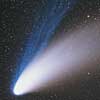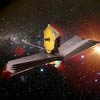|
Sunday:
September 14, 2003 | |
0107 GMT |
 |
Dark gamma-ray bursts more flighty than shy
Astronomers have solved the mystery of why nearly two-thirds of all gamma-ray bursts, the most powerful explosions in the Universe, seem to leave no trace or afterglow: In some cases, they just weren't looking fast enough.
 FULL STORY FULL STORY
 |  |

|
 |
Europe opens new window to our origins
A team of European astronomers has performed a uniquely detailed study of Comet LINEAR. As comets are believed to carry "pristine" material -- left-overs from the formation of the solar system, about 4,600 million years ago -- studies of these objects are important to obtain clues about the origins of the solar system and the Earth in particular.
 FULL STORY FULL STORY
 |  |

|
 |
|
Saturday:
September 13, 2003 | |
0117 GMT |
 |
Cosmic X-ray flashes reveal their distance
Astronomers using X-ray, radio, and optical telescopes have announced a big leap in solving the origin of mysterious objects known as X-ray flashes by finding that they originate from blue star forming galaxies. This discovery of the cosmic distant scale effectively ends the widely-held speculation that X-ray flashes are the death-cries from stars exploding in infant universe.
 FULL STORY FULL STORY
 |  |

|
 |
Marine picks first public Mars Global Surveyor image
If you were given a chance to aim the camera on NASA's Mars Global Surveyor Mars Orbiter and take a picture of something on the red planet, what would you shoot?
 FULL STORY FULL STORY
 |  |

|
 |
|
Friday:
September 12, 2003 | |
0125 GMT |
 |
Sunlight makes asteroids spin in strange ways
A new study has found that sunlight can have surprisingly important effects on the spins of small asteroids. The study indicates that sunlight may play a more important role in determining asteroid spin rates than collisions, which were previously thought to control asteroid spin rates.
 FULL STORY FULL STORY
 |  |

|
 |
Solar wind makes waves
"Killer" electrons capable of wreaking havoc on orbiting spacecraft may "surf" magnetic waves driven by the solar wind, according to a team of space scientists. The solar wind is a stream of electrically charged particles blown constantly from the Sun.
 FULL STORY FULL STORY
 |  |

|
 |
IN OTHER NEWS Additional stories making news today
|
 |
Alcatel wins contract to supply XM Radio satellite payload -- Boeing has selected Alcatel Space for a multi-million US dollar contract to build a digital radio broadcasting payload on behalf of XM Satellite Radio Inc., the leading satellite digital radio broadcaster in the United States. The payload will be built by Alcatel Space's facility in Toulouse, then integrated on a Boeing 702 platform in Boeing's facility in El Segundo, California.
|
 |
|
Thursday:
September 11, 2003 | |
0434 GMT |
 |
MIT researchers reassess asteroid hazards
Of the approximately 1,000 near-Earth asteroids larger than one kilometer in diameter, one strikes the Earth on average once every 600,000 years, MIT Lincoln Laboratory researcher J. Scott Stuart reported at a recent planetary sciences meeting.
 FULL STORY FULL STORY
 |  |

|
 |
Mirror for James Webb Space Telescope approved
NASA on Wednesday announced a major milestone in the development of the James Webb Space Telescope, the selection of a beryllium-based mirror technology for the telescope's 6.5-meter primary mirror.
 FULL STORY FULL STORY
 |  |

|
 |
IN OTHER NEWS Additional stories making news today
|
 |
EchoStar awards Lockheed Martin contract for new satellite -- Lockheed Martin Commercial Space Systems has been awarded a contract to build an A2100 geosynchronous satellite for EchoStar Communications Corp. The satellite, designated EchoStar 10, will provide distribution of direct-to-home broadcast services across the continental United States, Alaska and Hawaii following its scheduled launch in third quarter, 2005.
|
 |
|
Wednesday:
September 10, 2003 | |
0425 GMT |
 |
Chandra 'hears' a black hole
NASA's Chandra X-ray Observatory detected sound waves, for the first time, from a super-massive black hole. The "note" is the deepest ever detected from an object in the universe. The tremendous amounts of energy carried by these sound waves may solve a longstanding problem in astrophysics.
 FULL STORY FULL STORY
 |  |

|
 |
The slant on Saturn's rings
NASA's Hubble Space Telescope has captured detailed images of Saturn's Southern Hemisphere and the southern face of its rings during a recent study of the gas giant.
 FULL STORY FULL STORY
 |  |

|
 |
Photo gallery: Titan 4's midnight streak to space
This collection of images from Tuesday morning's launch of the Lockheed Martin Titan 4 rocket carrying a classified payload follows the first minutes of flight as seen from still and video cameras. It also includes some impressive time-lapse "streak shots" of the rocket's ascent from Cape Canaveral.
 ENTER GALLERY ENTER GALLERY
 |  |

|
 |
IN OTHER NEWS Additional stories making news today
|
 |
NASA, NOAA, Lockheed investigate satellite accident -- On Saturday, while performing work on the NOAA-N Prime weather spacecraft, being prepared to launch in 2008 for the National Oceanic and Atmospheric Administration, the satellite was dropped.

ILS Proton to launch Amazonas satellite -- International Launch Services will launch the Amazonas satellite for HISPASAT of Spain on a Proton/Breeze M vehicle next year under a contract announced Tuesday. The Amazonas launch, planned for mid-2004, is scheduled to be the first Proton mission for HISPASAT.

Wanted: Public's opinion about station research institute -- NASA released a draft Statement of Work for public comment Tuesday for a proposed International Space Station Research Institute. NASA seeks comments from industry, academia, organizations and individuals regarding contracting to a non-government organization to establish an Institute for International Space Station research management.
|
 |
|
Tuesday:
September 9, 2003 | |
0820 GMT |
 |
Titan 4 rocket launches cargo cloaked in secrecy
Riding over three million pounds of thrust from its two solid-fueled booster rockets, a Titan 4B launcher tore through a cloud-filled sky Tuesday morning to heave a massive national security cargo into space.
 FULL STORY FULL STORY
 MISSION STATUS CENTER MISSION STATUS CENTER
 |  |

|
 |

Video coverage for subscribers only:
 VIDEO: TITAN 4 ROCKET LAUNCHES WITH SECRET CARGO QT VIDEO: TITAN 4 ROCKET LAUNCHES WITH SECRET CARGO QT
 PANORAMA: 360-DEGREE VIEW OF TITAN 4 ON THE PAD QT VR PANORAMA: 360-DEGREE VIEW OF TITAN 4 ON THE PAD QT VR
 SUBSCRIBE NOW SUBSCRIBE NOW

|
European science equipment reaches station
Preparations for the Spanish Soyuz mission on the International Space Station in October took another step forward with the recent successful docking of an unmanned Progress spacecraft.
 FULL STORY FULL STORY
 |  |

|
 |
IN OTHER NEWS Additional stories making news today
|
 |
Proton to launch AMC-15 communications satellite -- International Launch Services and SES AMERICOM have set the launch of the AMC-15 satellite for the second half of 2004 on a Proton launch vehicle. The companies made the announcement Monday during the Euroconsult World Satellite Business Week conference.

ASTRA 1KR satellite to be launched by Arianespace -- Arianespace announced Tuesday that it will orbit the ASTRA 1KR telecommunications satellite under terms of a launch services contract signed by SES ASTRA.
|
 |
|
Monday:
September 8, 2003 | |
0001 GMT |
 |
Titan 4 rocket to put secret spy satellite into space
The United States is poised to place a giant reconnaissance satellite into orbit from Cape Canaveral for the first time in over five years Monday night using Lockheed Martin's heavy-lifting Titan 4B rocket.
 PREVIEW STORY PREVIEW STORY
 MISSION STATUS CENTER - updates! MISSION STATUS CENTER - updates!
 LAUNCH EVENTS TIMELINE LAUNCH EVENTS TIMELINE
 RESTRICTED LAUNCH HAZARD AREA RESTRICTED LAUNCH HAZARD AREA
 |  |

|
 |
Farthest, faintest solar system objects found
Astronomers using NASA's Hubble Space Telescope have discovered three of the faintest and smallest objects ever detected beyond Neptune. Each object is a lump of ice and rock -- roughly the size of Philadelphia -- orbiting beyond Neptune and Pluto, where the icy bodies may have dwelled since the formation of the solar system 4.5 billion years ago.
 FULL STORY FULL STORY
 |  |

|
 |

